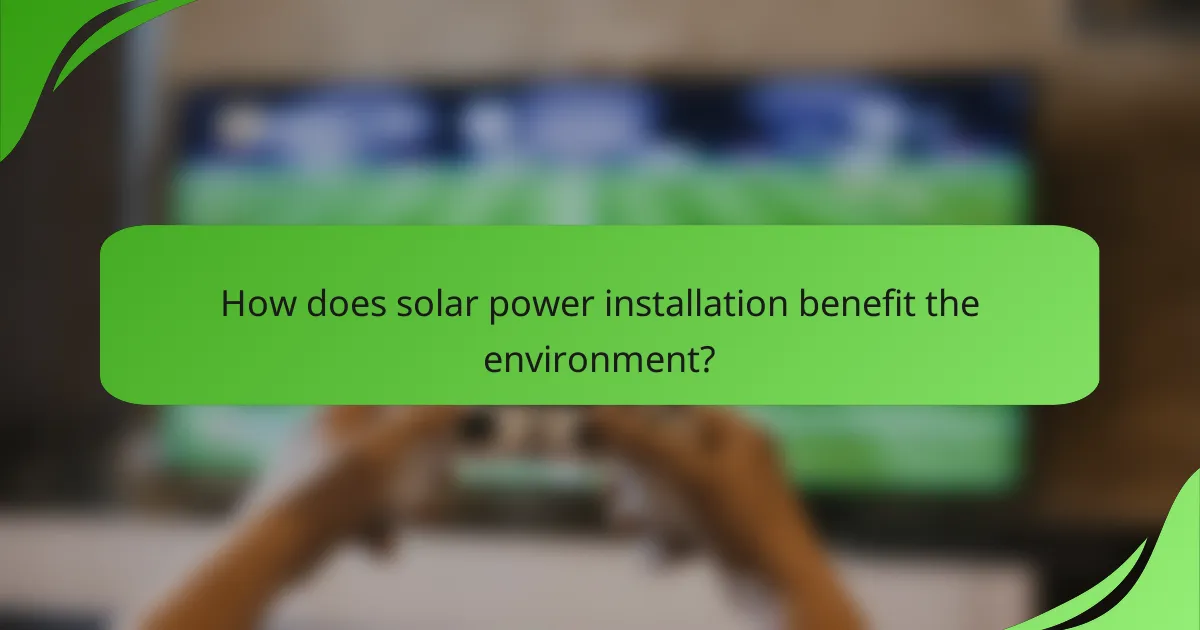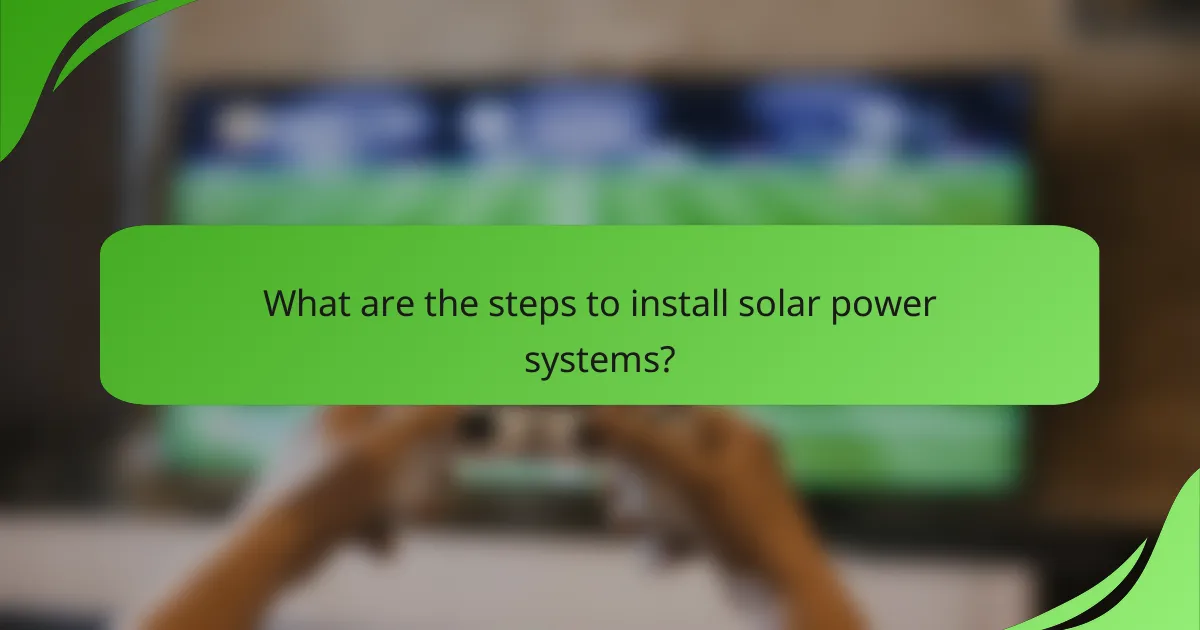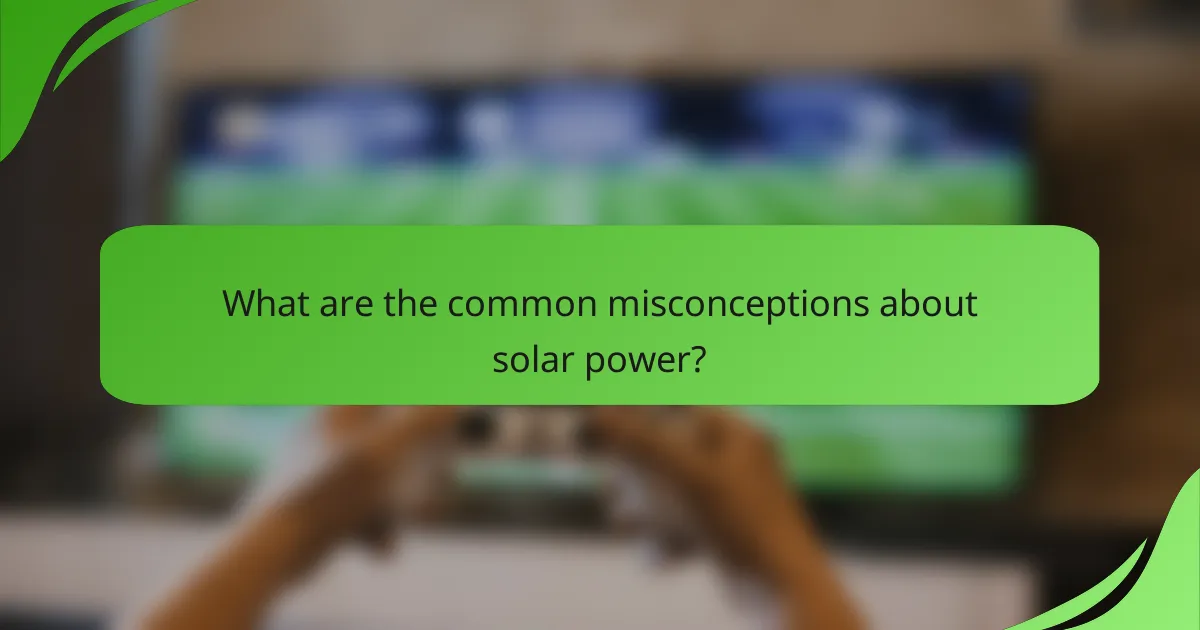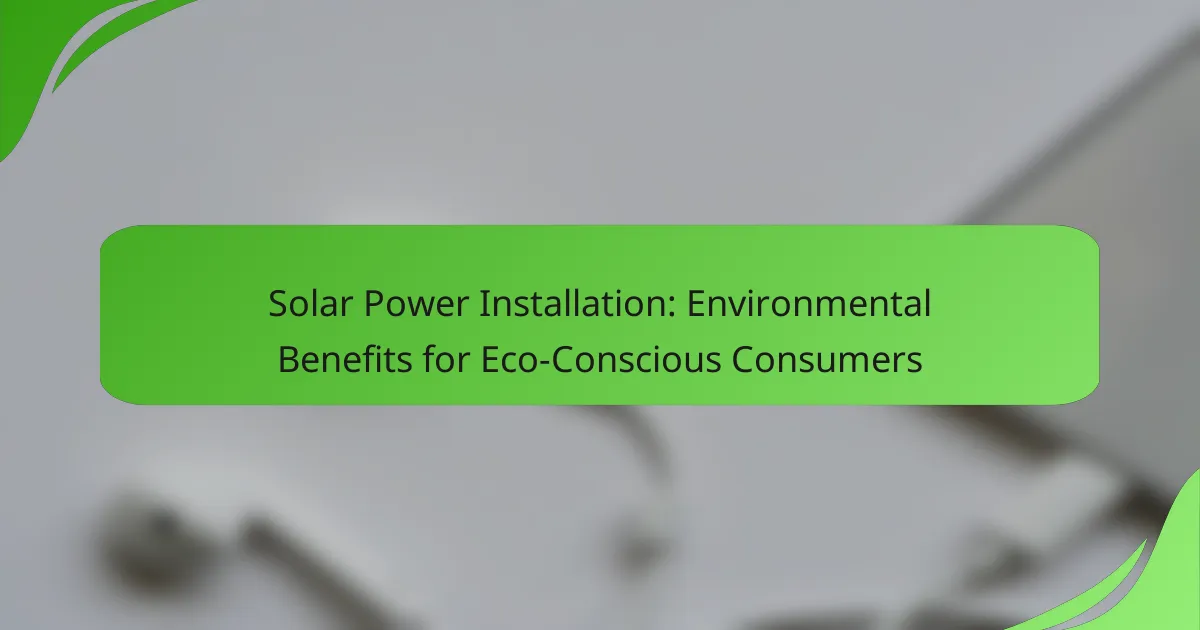Solar power installation offers substantial environmental benefits, primarily by decreasing dependence on fossil fuels and reducing greenhouse gas emissions. This shift to renewable energy not only supports a healthier ecosystem but also aligns with the values of eco-conscious consumers seeking sustainable solutions for their energy needs.

How does solar power installation benefit the environment?
Solar power installation significantly benefits the environment by reducing reliance on fossil fuels, which helps to lower greenhouse gas emissions. This transition to renewable energy sources fosters a healthier ecosystem and promotes sustainability.
Reduces carbon footprint
Installing solar panels directly decreases the carbon footprint of households and businesses by generating clean energy. By replacing conventional energy sources, solar power can cut carbon emissions by a substantial percentage, often in the range of 30-50% for typical users.
For eco-conscious consumers, this reduction in carbon output not only contributes to combating climate change but also aligns with personal values regarding environmental stewardship.
Conserves water resources
Solar power systems use minimal water compared to traditional energy generation methods, which often require significant water for cooling and processing. For instance, solar photovoltaic (PV) systems typically need less than 1% of the water used by coal or nuclear power plants.
This conservation of water resources is particularly crucial in arid regions where water scarcity is a pressing issue, making solar energy a more sustainable choice.
Decreases air pollution
Solar energy production emits no air pollutants, which helps to improve air quality. By reducing reliance on fossil fuels, solar installations can significantly lower harmful emissions such as sulfur dioxide and nitrogen oxides, which are linked to respiratory issues and other health problems.
As a result, communities that adopt solar energy often experience cleaner air, leading to better public health outcomes and a more pleasant living environment.
Promotes biodiversity
Solar installations can support biodiversity by providing habitats for various species when designed thoughtfully. Ground-mounted solar farms can coexist with agricultural practices, allowing for dual land use that benefits both energy production and local wildlife.
Additionally, solar projects can be integrated into existing ecosystems, helping to preserve natural habitats while generating renewable energy.
Supports sustainable energy practices
By investing in solar power, consumers actively support sustainable energy practices that reduce dependence on finite resources. This shift encourages the development of more renewable technologies and innovations in energy efficiency.
Moreover, solar energy contributes to a decentralized energy model, empowering communities to take control of their energy production and consumption, which is vital for long-term sustainability.

What are the financial incentives for solar power installation in the US?
In the US, financial incentives for solar power installation include federal tax credits, state rebates, and net metering benefits, all designed to reduce the overall cost of solar systems for homeowners and businesses. These incentives can significantly lower the upfront investment and enhance the return on investment over time.
Federal tax credits
The federal government offers a tax credit known as the Investment Tax Credit (ITC), which allows homeowners to deduct a substantial percentage of the cost of solar panel installation from their federal taxes. As of 2023, this credit is set at 30%, making it a powerful incentive for those considering solar energy.
To qualify, the solar system must be installed on your primary or secondary residence and meet specific requirements. It’s crucial to consult a tax professional to ensure you maximize this benefit and comply with all regulations.
State rebates and incentives
Many states provide additional rebates and incentives to encourage solar power adoption. These can vary widely, with some states offering cash rebates that can cover a portion of installation costs, while others may provide property tax exemptions or sales tax exemptions on solar equipment.
Research your state’s specific programs, as they can change frequently. Websites like the Database of State Incentives for Renewables & Efficiency (DSIRE) can help you find relevant incentives in your area.
Net metering benefits
Net metering allows solar panel owners to receive credits for the excess electricity their systems generate and feed back into the grid. This can significantly reduce monthly utility bills, as these credits can offset future energy costs.
Each state has different net metering policies, including how credits are calculated and whether they expire. Understanding your local net metering rules is essential to fully benefit from this incentive, as it can enhance the financial viability of your solar investment.

What are the steps to install solar power systems?
Installing solar power systems involves several key steps that ensure a successful and efficient setup. From assessing your site to the final installation, each phase is critical for optimizing energy production and meeting local regulations.
Site assessment
The site assessment is the first step in the solar installation process. This involves evaluating your property to determine its solar potential, which includes analyzing roof orientation, shading from trees or buildings, and available space for solar panels.
During this phase, a professional may use tools like solar pathfinders to measure sunlight exposure throughout the year. It’s essential to consider local climate conditions, as they can significantly impact solar energy generation.
System design
Once the site assessment is complete, the next step is system design. This phase includes selecting the appropriate type and number of solar panels, inverters, and other components based on your energy needs and budget.
Designers will create a layout that maximizes efficiency while adhering to local building codes. It’s beneficial to compare different system configurations to find the best fit for your specific circumstances.
Permitting process
The permitting process is crucial for ensuring that your solar installation complies with local regulations. This typically involves submitting your system design to local authorities for approval before installation can begin.
Requirements can vary widely by location, so it’s important to check with your local government or a solar installer familiar with regional regulations. Delays in permitting can extend the timeline for your project, so plan accordingly.
Installation phase
The installation phase is where the actual solar power system is put in place. This typically involves mounting solar panels on your roof or on a ground structure, connecting wiring, and installing the inverter.
Hiring experienced professionals can help ensure that the installation is done correctly and safely. After installation, a final inspection may be required to confirm that everything meets local codes and standards before the system is activated.

How to choose the right solar power provider?
Choosing the right solar power provider involves evaluating local options, comparing customer experiences, and understanding warranty offerings. This ensures you select a reliable company that meets your specific energy needs and budget.
Research local providers
Start by identifying solar power providers in your area. Look for companies that have a solid reputation and are familiar with local regulations and incentives, such as tax credits or rebates available in your region.
Check if the providers are licensed and insured, as this can protect you from potential liabilities. Local providers often have better knowledge of the installation process and can offer tailored solutions based on your location’s climate and energy needs.
Compare customer reviews
Customer reviews are a valuable resource when selecting a solar power provider. Look for feedback on platforms like Google, Yelp, or specialized solar review sites to gauge overall satisfaction and service quality.
Pay attention to recurring themes in reviews, such as installation efficiency, customer service responsiveness, and post-installation support. A provider with consistently positive reviews is more likely to deliver a satisfactory experience.
Evaluate warranty options
Warranties can vary significantly among solar power providers, so it’s crucial to understand what is covered. Look for warranties that cover both the solar panels and the inverter, typically lasting 20-25 years for panels and 5-10 years for inverters.
Ensure that the warranty includes coverage for workmanship, as this protects you against installation-related issues. A strong warranty can provide peace of mind and long-term savings by reducing potential repair costs.

What are the common misconceptions about solar power?
Many people believe that solar power is too expensive, inefficient, or only suitable for sunny climates. In reality, solar technology has advanced significantly, making it more affordable and effective in various environments.
Solar panels are too expensive to install
While the initial investment for solar panel installation can be substantial, costs have decreased dramatically over the past decade. Many consumers find that government incentives, tax credits, and financing options can reduce upfront expenses significantly, making solar power more accessible.
Additionally, the long-term savings on electricity bills often outweigh the initial costs. Homeowners can expect to recoup their investment within a few years, especially in regions with high energy prices.
Solar power only works in sunny areas
Another common misconception is that solar panels require constant sunlight to function effectively. In reality, solar panels can generate electricity even on cloudy or rainy days, although their efficiency may be reduced. Many systems are designed to capture diffuse sunlight, ensuring energy production in various weather conditions.
Moreover, advancements in solar technology have improved performance in less-than-ideal conditions, making solar power a viable option in a wider range of climates.
Solar energy is not reliable
Some people believe that solar energy is unreliable due to its dependence on weather conditions. However, modern solar systems often include battery storage, allowing homeowners to store excess energy for use during cloudy days or at night. This capability enhances energy reliability and provides greater independence from the grid.
Additionally, solar power can be integrated with other energy sources, such as wind or traditional electricity, to create a more stable energy supply.
Solar panels require a lot of maintenance
Many consumers worry about the maintenance needs of solar panels. In fact, solar systems are designed to be low-maintenance, requiring only periodic cleaning and inspections. Most manufacturers offer warranties that cover performance and defects for 20-25 years, providing peace of mind.
Regular maintenance can help ensure optimal performance, but it typically involves simple tasks that homeowners can manage themselves, such as removing debris or dust from the panels.
